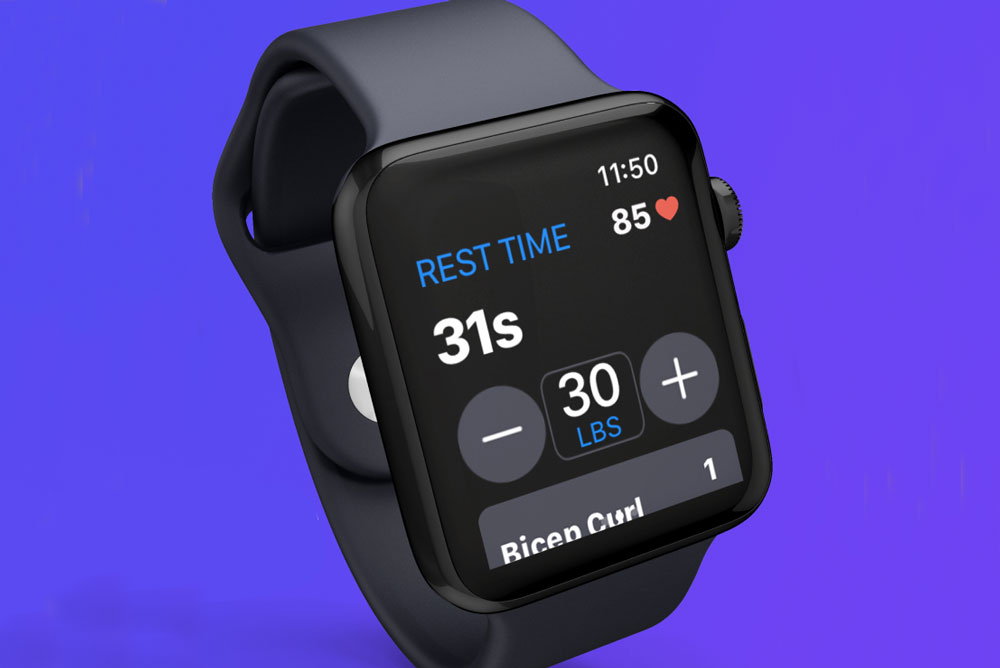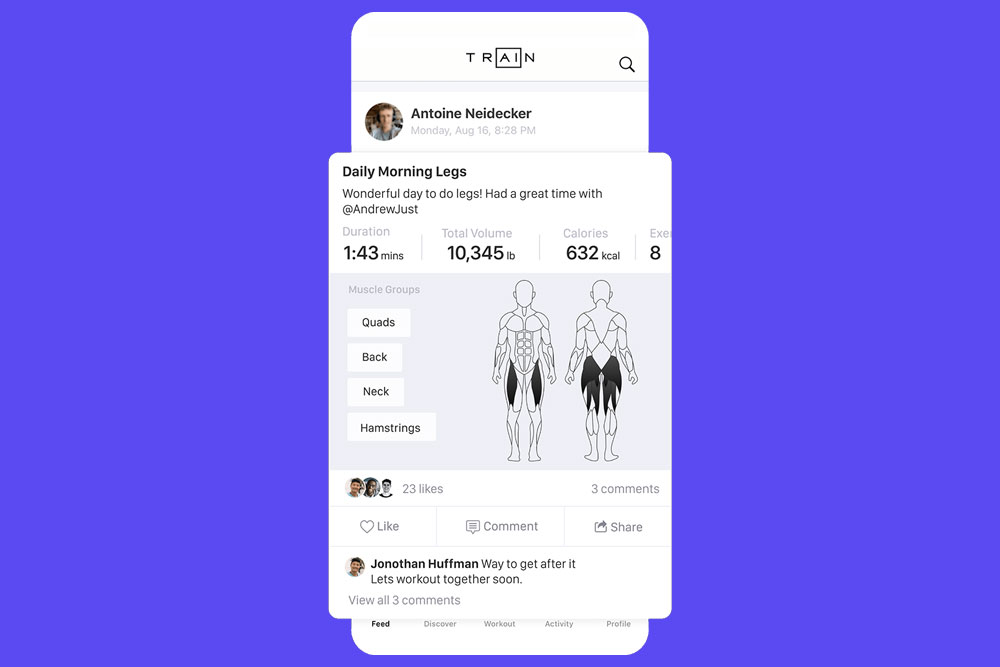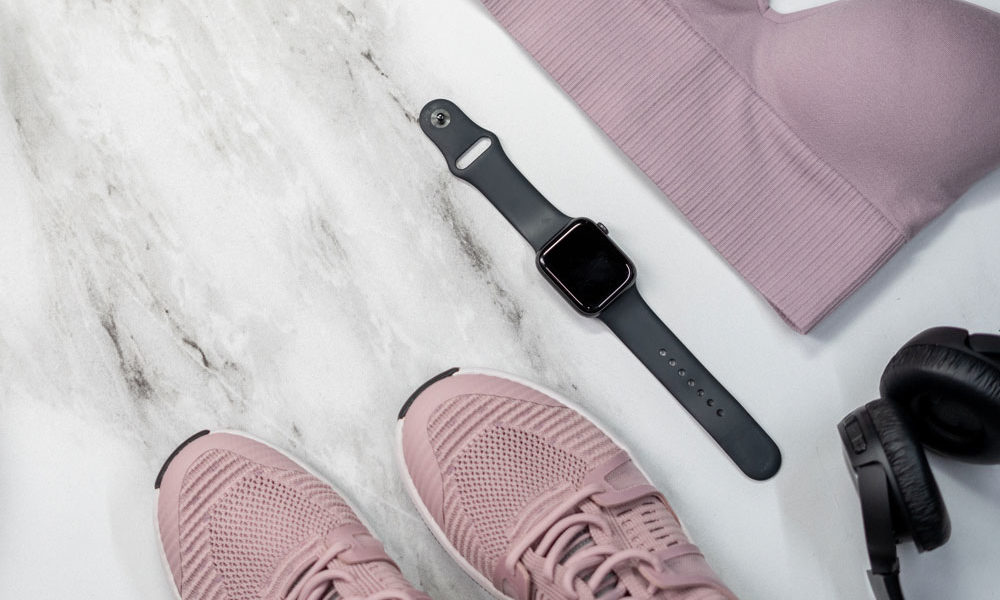Tracking calories, kilometres and claps is the world we all move in. And – I don’t know about you – but I actually crave it. I check my macro app to see if I need more protein. I’m always looking at the distance on my Peloton sesh to see if I pushed myself hard enough. And, if you high-five me, I’ll do it back asap. And I don’t need a study to tell me that I’m not alone for this kind of motivation – the entire fit tech industry is based on it. So, I’m not surprised that Train Fitness Workout Tracker app developer and founder Andrew Just craved the same thing from his strength workouts, which inspired him to create AI for fitness.
As a runner, he used Strava to track KMs for marathon prep. So when he went to the gym, he found having to log his reps, either by app or a good ol’ fashioned pen and paper, to be distracting. It caused pauses in his workouts that he felt could be used more efficiently by moving. Could he create AI for his workouts?
What to expect from the “50 Crunches A Day For 30 Days” challenge.
What exactly is AI for fitness?
AI stands for artificial intelligence. It’s when a computer can do the tasks that we would normally do ourselves. And, in the case of AI for strength workouts, it’s the ability for a computer to recognize the movement for what it is (a plank is different than a squat which is different than burpees).
For example, Peloton launched Guide, which uses a camera to track movement during the count for a specific exercise using “sweat points” and recommends classes based on your workout history on the app (not other workouts you do, though).
Train Fitness is an Apple Watch 4 app. Like how your Hermès strapped watch tracks your steps and flights climbed using GPS and accelormetres, it can also track data from the movement of your exercises when using the Train Fitness app (and an Apple Watch Series 4 or later). The motions you take your Apple Watch on your arm through for a biceps curl are different than a shoulder press. So Just decided when the 2020 lockdowns hit, he would gather as much fitness data for Apple Watch as he could to build an app that would count the reps, without having to input anything other than the weights used.
So, now that we got that bit of info out of the way, let’s dive into my chat with Just and his app about how it works.
What is the Peloton Guide? Should you add to cart?
Where did you get the idea to create a fitness app that used AI?
I was still in university at the time, and I was working out at the gym. I come from a triathlon and running background, and at the time was very inundated and focused on the data and the analytics from my training. At university, my focus switched from cardio to anaerobic and weightlifting. I was surprised to see that a lot of the tools that I loved for cardio didn’t exist for strength workouts. There was no way to automatically track your workout, gather your stats or find out power or output. And for me, if I couldn’t track it, I couldn’t analyze it and perform better. I was at the gym, where I realized if there was a way to automatically track my workout, I would just be so much better off. I could have an app analyze it, or analyze it myself, to understand where there are opportunities for me to improve and better perform as an athlete.
Virtual Workouts vs IRL: Which way to exercise is more effective?
How many exercises can the Train app track?
Right now, it supports 100. By mid-summer 2022, we expect to support over 200. The goal is to be at over 300 by the end of the year.
We are planning to support a wide range of exercises from complete beginners to experts and those at Olympian levels. That’s everything from a simple jumping jack or an unweighted lunge or skipping rope, all the way up to a clean and snatch or advanced to Olympic lifts.

So, how the bleep does the Apple Watch know what exercises I’m doing without me even telling it?
We use artificial intelligence to detect the exercise. It uses only the motion of the Apple Watch. And based on the motion path (he moves his arm as if he’s doing a squat), we’re able to understand or predict what exercise users are doing.
But in order for that artificial intelligence to be “taught,” you need to show the AI engine what each individual exercise type will look like. It needs example paths of what a bicep curl moves like, what a chest press looks like, or whatever it might be.
In order to do that, we needed lots of examples or data of these exercises. And we needed them to come from different demographics of people.
I wish I could have just done 500 bicep curls and called it a day. But that’s not how it works. The AI would have been really good at counting my reps, but not those of someone taller than me or more experienced than me or less experienced than me. So we needed to include old, young, tall, short, beginner and experienced biceps curls to really understand what the entire demographic looks like when they do this exercise.
I started in March 2020. And to paint the picture, we needed 100 people to do 20 different types of exercises. And for each exercise type, they had to do three sets of eight reps. We needed to collect 100,000 reps of data.
So what I ended up doing was get a minivan and retrofitted the back with home gym equipment, such as barbells, dumbbells, kettlebells, yoga mats, and more. I spent that summer and fall driving around Ontario, meeting people in driveways, parking lots and parks.
I filmed them performing these exercises to understand what they look like, and to give the AI the data. It was quite an experience driving all over Ontario and meeting friends.
And at the start, I wasn’t paying people. So I was calling in favours, convincing friends and family to do a workout with me out in a park. It was definitely very fun, a little awkward, but super rewarding.
Peloton Tread Review: Is it worth the money?
What doesn’t it do!?
Right now the biggest limitation we have is that it is only focused on traditional weightlifting and strength training. We don’t support Pilates. We don’t support yoga. Yet. We don’t support more complex types of weightlifting, like callisthenics, and even a select few CrossFit exercises. We support all the most-common exercises for lower and upper body exercises.
Can Train please be my “form police”?
We had a good array of individuals that did the exercises with poor form, and we deliberately sought out people who had never lifted weights before. Bless their souls, some had horrendous form. But that would allow us to be able to track individuals that don’t do it with good form. Now, having said that, if you’re doing an upright row that looks more like a jumping jack, then then we won’t be able to detect that.
We’re working on technology right now that will correct form for each exercise. The attributes that we’ll be able to attack are the range of motion, the time under tension, the acceleration, the velocity and the motion path of the exercise. So if we take, for example, a back squat, will actually be able to tell if you’re not going down deep enough, if you’re going too fast, if you’re going too slow, if you’re rounding your back, if you’re leaning too far forward, all based off of the way that the watch rotates, or moves through 3d space. And what we’re hoping to do in the coming months is actually then give our users real-time, audio prompts in their headphones, to be able to say, you know, hey, Andrew, you’re leaning too far forward on the squat, or you’re not going down deep enough, you’re like, should be at 90 degrees at the bottom of your squat to be able to give people real-time feedback to improve as they workout.
Hands down, the easiest fix – How I stopped wrist pain during exercise.
You mentioned the wide ranges of bodies you collected data for. How inclusive is Train?
Actually, one of the issues we were facing is that – up until about a month ago – we only supported the watch on the left arm. When we collected all the data, we just chose one hand out of simplicity. We got a lot of feedback from users that it wasn’t super inclusive to have only the left hand supported. That meant whether you’re an amputee or you have limitations with the left arm, basically, you wouldn’t be able to use the app. So we went back to the drawing board and did a bunch of math calculations to be able to understand what the left versus right hand looks like because for some exercises, the motion path is slightly different. I am super proud of our team for being able to do this.
How many members does Train have?
We did a soft launch on September 15, 2021, officially available in the App Store. We did a full launch in January 2022. As of right now, we’ve had about 12,000 downloads. And we have about 5,000 weekly active users. We’re growing at about 70% month over month. So we’re early May, so even like two months ago, we had hundreds of users, and we’re already at 5,000.
The best gyms in Toronto: Where the city’s fitness pros work out.
Any privacy concerns for users?
That’s a question we get asked a lot. We don’t keep any health data on our apps at all. We pass it all through what’s called the Apple Health Kit. It’s a central repository of data for all things health, including your age, height, weight, heart rate, and things like that. And when you download the Train app, you’ll see that one of the first things we ask is if you want to share, both send and receive health data with Train Fitness Through the Apple Health Kit. You can approve that or deny it.

How will this motivate me to get off my butt on days when I just don’t want to workout?
We did extensive research and testing and spoke to users and focus groups, and what we found is that if our app just simply sends you a push notification that says, “Hey, Lisa, you should work out today,” you’re just going swipe the message away. It’s too easy to ignore an auto-generated message.
What’s difficult to ignore is peer pressure for your friends and the accountability driven through social media. So every time you work out, your data can be sent onto your Train social feed. And, I’m following you, and you’re following me, so I can see the days you work out. I get a push notification that says, “Hey, Lisa, crushed your goal this week and did 120 minutes of working out.” Or if I see, “Hey, Lisa didn’t quite nail her goal this week.” That creates social pressure that is far more difficult to ignore. It holds people far more accountable than anything else.
Also, part of our objective and overall mandate to make people healthier and fitter and live more active lifestyles, is to keep the app relatively affordable.
Just says the Train Fitness app is free for Apple users right now, but it will eventually have a subscription model, which will cost under $10 a month to start. For more info visit the App store.

